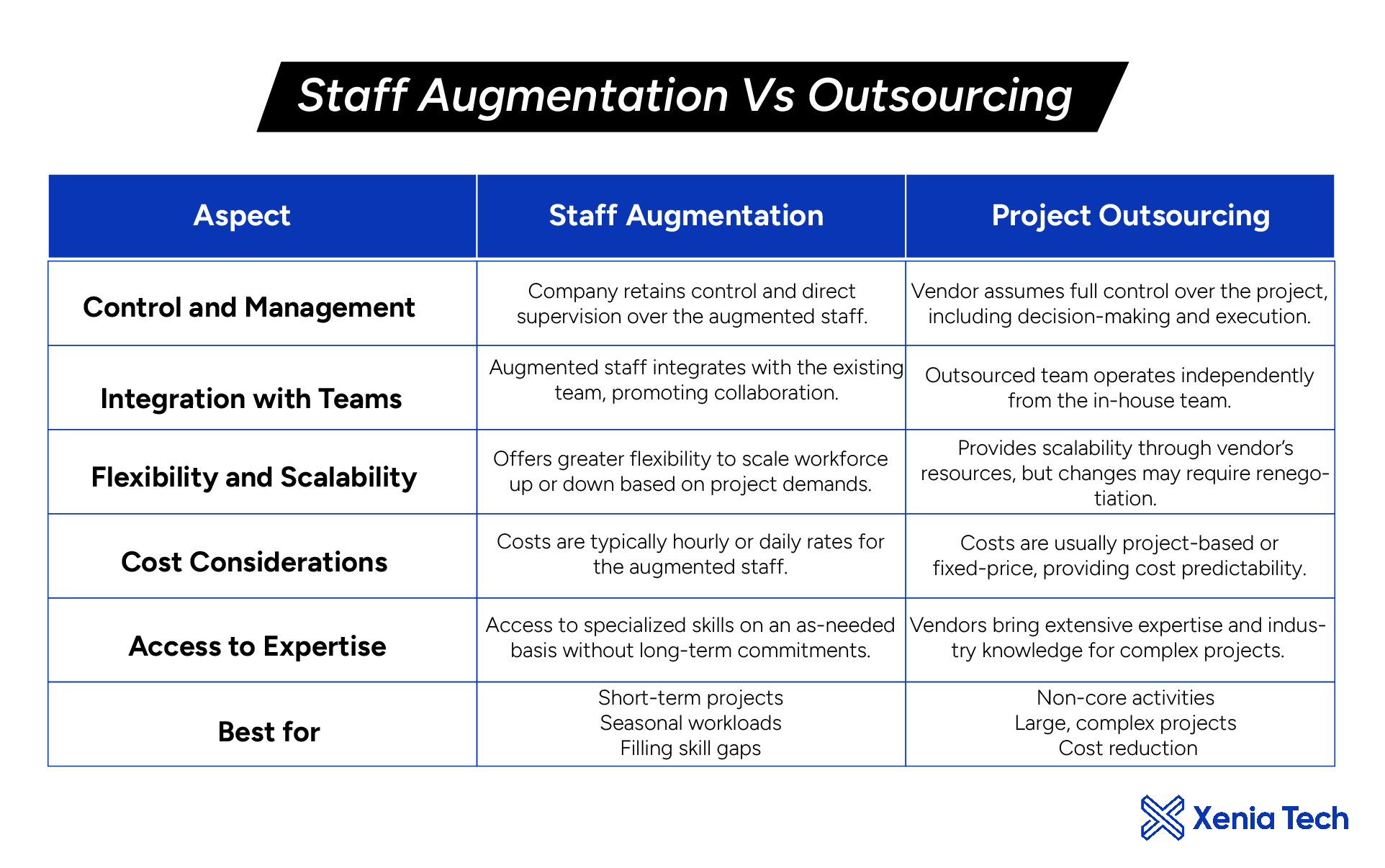-> Choosing the Right IT Outsourcing Company for Your Project
Staff Augmentation vs Project Outsourcing
1. Control and Management
- Staff Augmentation: The company retains control over the project and the augmented staff, allowing for direct supervision and management of tasks, and ensuring alignment with company standards and goals. For example, a software development company needing additional developers for a new app feature can hire temporary developers who work directly under the existing project manager.
- Project Outsourcing: The vendor takes full control of the project, making decisions and executing tasks. This can be both good and bad, depending on the project’s needs. For example, a small business needing a new website can outsource the entire project to a web development agency, which manages everything from design to launch.
2. Integration with Existing Teams
- Staff Augmentation: Augmented staff members work alongside the existing team, fostering collaboration and knowledge sharing. This integration can enhance team cohesion and project continuity. An example is a retail company that augments its IT support team during the peak holiday season with additional technicians who work seamlessly with the in-house team.
- Project Outsourcing: The outsourced team operates independently from the in-house team. While this can streamline project execution, it may result in less interaction and collaboration between internal and external teams. For example, a manufacturing company implementing a new ERP system might outsource the project to a specialized ERP consulting firm, which manages the implementation independently.
3. Flexibility and Scalability
- Staff Augmentation: This approach offers greater flexibility to scale the workforce up or down based on project demands. It is ideal for short-term projects or fluctuating workloads. A marketing agency, for instance, can bring in freelance graphic designers for a large, short-term campaign, scaling down once the project is completed.
- Project Outsourcing: Outsourcing provides scalability through the vendor’s resources, but changes to project scope or requirements may involve renegotiating contracts and terms. An e-commerce business outsourcing the development of a new mobile app can benefit from the vendor’s ability to scale their team to meet the launch deadline.
4. Cost Considerations
- Staff Augmentation: Costs are typically based on the hourly or daily rates of the augmented staff, which can be more cost-effective for short-term needs or specific skill sets. For example, a tech startup might need a data scientist for a six-month project and find it more economical to hire a temporary expert.
- Project Outsourcing: Costs are usually project-based or fixed-price, providing cost predictability. However, additional costs may arise if the project scope changes. For instance, a financial services firm outsourcing the development of a new cybersecurity system might benefit from a fixed project cost, ensuring budget adherence.
5. Access to Expertise
- Staff Augmentation: Companies can access specialized skills on an as-needed basis without committing to long-term employment. This is beneficial for projects requiring niche expertise. A biotech firm developing a new software tool can bring in a bioinformatics expert for the project’s duration, accessing essential skills without a long-term commitment.
- Project Outsourcing: Vendors bring a wealth of expertise and industry knowledge, often delivering higher-quality outcomes for complex projects. For example, a healthcare provider implementing a telemedicine platform might outsource to a company specializing in healthcare IT solutions, ensuring the project benefits from comprehensive expertise.
When to Choose Staff Augmentation
- Ideal for Short-Term Projects: Perfect for projects with defined timelines and specific skill requirements.
- Perfect for Seasonal Workloads: Useful during peak business periods when additional resources are needed.
- Filling Skill Gaps with Precision: Effective when in-house teams lack certain technical skills or expertise.
When to Opt for Project Outsourcing
- Best for Non-Core Activities: Suitable for tasks that are not central to the business’s primary operations.
- Complex, Large-Scale Projects: Ideal for projects requiring specialized expertise and resources.
- Effective Cost Reduction Strategies: Beneficial for reducing operational costs by leveraging the vendor’s efficiencies.
Comparison Table:

Enhancing Your Workforce Strategy
In conclusion, both staff augmentation and project outsourcing offer valuable benefits depending on your business needs and project requirements. By understanding the key differences between these two approaches, you can make informed decisions that enhance your workforce strategy and drive project success.




